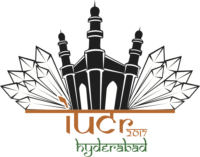The opening of the 24th congress and general assembly of the International Union of Crystallography
The opening of the 24th congress and general assembly of the International Union of Crystallography was marked by a splendid programme that stressed, time and again, the international nature of our crystallographic community. When Professor Gautam Desiraju, the organising committee chair and immediate past president of the IUCr, quoted one of the discipline’s founding fathers, W. L. Bragg, in his welcome address: “At a scientific conference nationality disappears” he could have been summing up the whole event.
Certainly, this is the most diverse IUCr congress yet, as Desiraju explained. There are representatives of 73 countries here in Hyderabad, more than the 58 national members of the International Union. India is represented by over 500 delegates and the other BRICS countries – Brazil, Russia, China and South Africa – have all sent substantial delegations. The challenges and opportunities for scientists in these very different but in many ways surprisingly similar emerging countries will be discussed later in the week. Several countries including the Cameroon and Myanmar have sent a single delegate, but the most significant example of the ‘borderless’ nature of crystallography might be the 17 delegates from Bangladesh. Three of these are students who have joined the band of enthusiastic conference volunteers on equal terms with their domestic counterparts.
The IUCr President, Marvin Hackert of the University of Texas, Austin, gave a talk running through the history of the Union and its congresses. Like independent India, the IUCr was ‘born’ in 1947, and its international congress has taken place every third year since 1948. It has grown out of recognition since those early days but its basic roles are essentially unchanged: maintaining standards, publishing books and journals (including the International Tables) and promoting international collaboration. And a number of new initiatives have been started in or after the highly successful International Year of Crystallography in 2014. These include the LAAMP project – or the Lightsources for Africa, the (Southern) Americas and Middle East Project – to provide greater access to advanced synchrotron sources for scientists working in these disadvantaged regions. India already has two such sources, with others planned.
Paul Peter Ewald, a pioneering crystallographer known to students of structural science throughout the world for his ‘Ewald sphere’, was one of those principally involved in setting up the IUCr. Since 1986, his memory has been honoured by the award of the Ewald Prize at each congress to a distinguished crystallographer. The 2017 prize was therefore the eleventh in the series; it was awarded to Sir Tom Blundell from the University of Cambridge, UK, a pioneering structural biologist and a co-founder of Astex Pharmaceuticals.
Blundell’s prize lecture was a tour de force, a whirlwind summary of half a century at the forefront of structural biology. Time and again, he came back to the importance of collaboration, both between nationalities and between academic and industrial scientists. And time and again he came back to his mentor, Nobel laureate Dorothy Hodgkin. He joined Hodgkin’s lab as a student in 1964, the year in which she won the Chemistry Nobel, and became a member of the group that solved the 3D structure of insulin. He described giving his first plenary lecture at an international conference as a 27-year-old in 1969, showing delegates at the eighth IUCr congress the newly-solved structure of that vitally important biological molecule.
During his talk, he drew out four ‘lessons’ from Dorothy Hodgkin’s example and the insulin story, illustrating them with anecdotes from throughout his career. Firstly, he explained that good science requires a long-term vision by citing the thirty years between the first insulin crystals and the first publishable 3D structure. There are lessons here for today’s grant agencies and journal editors. His second point stressed the value of international and interdisciplinary teams and his third the importance of writing up experimental methods: Protein Crystallography, the book he co-authored with Louise Johnson in 1976, was the first authoritative textbook on this subject.
Blundell devoted most time to the fourth ‘lesson’, on the value and quality of industrial science. He has collaborated with the pharma industry since the Seventies – then perhaps rather improbably as a left-wing firebrand of an Oxford City councillor. His was one of the groups that simultaneously solved the structure of HIV’s protease, paving the way for some of the most successful drugs for AIDS. In 1999 he and two ex-colleagues, Harren Jhoti and Chris Abell, founded Astex to pioneer the technique of fragment-based drug discovery. This company is now wholly owned by Otsuka Pharmaceuticals in Japan, and eighteen years after the program was launched, its first drug, riboclicib, has just received FDA approval for breast cancer. Dorothy Hodgkin herself would recognise this time-scale. Blundell is now taking the technologies pioneered at Astex back into academia for complex targets and neglected diseases, the latter with generous funding from the Gates Foundation. Despite passing the ‘official’ retirement age he still has plenty of plans for his international, interdisciplinary team, and for what his mentor might have called ‘useful’ crystallography; I will be reporting on more of both throughout the meeting.
Dr Clare Sansom, Department of Biological Sciences, Birkbeck College, London, UK
